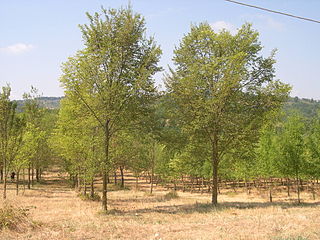
Morchella, the true morels, is a genus of edible sac fungi closely related to anatomically simpler cup fungi in the order Pezizales. These distinctive fungi have a honeycomb appearance due to the network of ridges with pits composing their caps. Morels are prized by gourmet cooks, particularly in Catalan and French cuisine, but can be toxic if consumed raw or undercooked. Due to difficulties in cultivation, commercial harvesting of wild morels has become a multimillion-dollar industry in the temperate Northern Hemisphere, in particular North America, Turkey, China, the Himalayas, India, and Pakistan where these highly prized fungi are found in abundance.

The Battle of Cartagena occurred on May 13, 460 and was part of the wars of Majorian. Although many sources call it battle of Cartagena, the battle did not take place at Cartagena but on the coast of Roman Carthaginensis province at Portus Ilicitanus in the bay of Alicante. Since Portus Ilicitanus was the port of Elche (Ilici), the battle is sometimes referred as battle of Elche.
460: Eo anno captae sunt naves a Vandalis ad Elecem juxta Carthaginem Spartariam.

Satyrium ilicis, the ilex hairstreak, is a butterfly of the family Lycaenidae.

Ulmus 'Arno' is an Italian hybrid cultivar derived from a crossing of 'Plantyn' with the Siberian Elm Ulmus pumila clone S.2. It was raised by the Istituto per la Protezione delle Piante (IPP) in Florence, and released in 2007. However, 'Arno' was not a commercial success; propagation had ceased by 2010, and it is no longer patent protected.

A fungus is any member of the group of eukaryotic organisms that includes microorganisms such as yeasts and molds, as well as the more familiar mushrooms. These organisms are classified as one of the traditional eukaryotic kingdoms, along with Animalia, Plantae and either Protista or Protozoa and Chromista.

Rhytisma acerinum is a plant pathogen that commonly affects sycamores and maples in late summer and autumn, causing tar spot. Tar spot does not usually have an adverse effect on the trees' long-term health. R. acerinum is an Ascomycete fungus that locally infects the leaves of trees and is a biotrophic parasite. The disease is cosmetic and is therefore usually controlled only with sanitation methods.

Guignardia is a genus of fungi in the family Botryosphaeriaceae.

The Rhytismataceae are a family of fungi in the Rhytismatales order. It contains 55 genera and 728 species.
Calycellina is a genus of fungi in the family Hyaloscyphaceae. The genus contains about 43 species.
Urceolella is a genus of fungi within the Hyaloscyphaceae family. The genus contains 23 species. Species Fungorum accepts 44 species.

Phytomyza ilicis, the holly leaf miner, is a leaf mining fly in the family Agromyzidae, whose larvae burrow into leaves of the holly tree leaving characteristic pale trails or leaf mines.

Ilići is a suburban neighborhood of Mostar, Bosnia and Herzegovina, centered on the main strip of Ilićka Street immediately west of downtown and extending until the spring of Radobolja river.

Radobolja is a river in Bosnia and Herzegovina. It is five kilometers long and its spring is located below the Mikuljača hill in Mostar's suburb of Ilići. Radobolja flows through Mostar and flows into the Neretva River near the Old Bridge. During the Ottoman rule water from Radobolja was used for irrigation and drinking, however today's Radobolja is polluted due to discharge of waste-water.

The genus Phaeoclavulina comprises approximately 55 species of coral fungi.
Plinthograptis rhytisma is a species of moth of the family Tortricidae. It is found in Nigeria.
Rhytisma is a genus of soft corals in the family Alcyoniidae.

Rhytisma fulvum, the sulphur leather coral, is a species of colonial soft coral in the family Alcyoniidae. It is native to shallow reefs in the Red Sea and the Indo-Pacific region. It was first described by the Swedish naturalist Peter Forsskål in 1775.
Morchella kakiicolor is a species of fungus in the family Morchellaceae (Ascomycota). It was originally proposed as a form of Morchella quercus-ilicis in a 2012 study by Philippe Clowez, but was later re-combined as an autonomous species by Loizides and colleagues, based on molecular phylogenetic data. In the same study, M. quercus-ilicis f. quercus-ilicis was shown by the authors to be a later synonym of the old taxon Morchella tridentina, and not phylogenetically related to M. kakiicolor.

Fumago is a genus of fungi belonging to the family Capnodiaceae.














